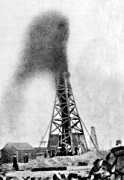Admiral Thad Allen, National Incident Commander for Gulf Oil Spill:
“What we want to do is, take as much pressure coming from the well bore as possible, and put that into production.”
As seen on CBS news tonight.
Admiral Thad Allen, National Incident Commander for Gulf Oil Spill:
“What we want to do is, take as much pressure coming from the well bore as possible, and put that into production.”
As seen on CBS news tonight.

Here are a few simple questions:
I have little doubt that if you subtract the answers to #2 and #3, from the answer to #1, you’ll still get a very large positive number.
If BP can manage to figure out how to pump most or all of the gushing oil into ships on the surface, they stand to make a lot of money. But they have to make sure they still have access to the flow.
Let’s say there were some more aggressive way to stop, plug, cap, destroy, or otherwise end the slow-motion environmental disaster we’re all witnessing. But what if this aggressive solution would end access to the oil that they expected to reap in #1 above.
That very large positive number I mentioned — that’s the amount of money that BP could stand to lose by doing the Right Thing.
So how much money is typically made from a modern deep-sea oil well in the Gulf of Mexico these days? A billion dollars? Five billion? Fifty?
Apparently Exxon paid about $500M in clean-up costs, and another $510M in settlements. Add to that a couple hundred million in legal fees and we’re in at well under two billion dollars.
Does BP expect to spend $2B or even $5B on clean-up, legal fees, fines and settlements? Say it were $10B. If the well makes them $50B, then they’re still net-positive by $40,000,000,000.
I have no idea if these numbers are anywhere near realistic. Where are the experts who should be talking about this math? I haven’t heard from them.
Ok, so I don’t have real data, but let’s do a back-of-the-envelope calculation.
#2: Estimates of the spill vary by more than order of magnitude, but say for the sake of argument that it’s leaking 50,000 barrels of oil per day. At $100/barrell, that’s $5M/day, or $225M over the 45 days since the disaster started. That’s $225M so far. Say it lasts for a year — that’s about 1.8 billion dollars in lost oil. Call it a clean $2B.
#3: Say the spill ends up costing BP roughly 10 times what the Valdez spill cost Exxon. I don’t have exact numbers, but I think it was about $1.2B for Exxon. Round up to $15B.
#1: An oil well’s life might be more than 20 years. Unfortunately it’s hard to predict how how long a well will be productive, or what its yield will be. Let’s be conservative on the time-line and call it 10 years at 150,000 barrels per day. (Atlantis, a very similar rig to Deep Horizon, produces up to 200K barrels a day.) That’s about 54.75M barrels/year, or 547M over 10 years. At $100/barrel, we’re looking at $54B gross over the lifetime of the well. Subtracting say $400K/day for operating costs (about $1.5B over 10 years): About $52.5B.
So here’s the back of the envelope:
Lost oil, plus clean-up costs: $2B + $15B = $17B
Projected net, minus disaster expense: $52.5B – $17B = $35.5B
So here’s that very large positive number I was talking about:
$35,500,000,000.00
Thirty-five-and-a-half Billion dollars. That’s the amount of money BP might stand to lose if the well were sealed in a permanent way, that prevented them from getting at the oil.
After weeks and weeks of deadlines at work, and sickness and minor injuries at home, I finally had some time to get back to work on UserLand this weekend.

There are still too many servers running UserLand’s sites, making the hosting fees higher than they need to be, which of course limits the amount of time available to get things under control, so the first priority is still to consolidate servers. Not only does this reduce costs, but it also makes it easier to migrate later if necessary.
A couple of weeks ago, I moved radio.userland.com to the main UserLand server that hosts the UserLand.com site, and the Manila and Frontier sites. I started work tonight on another server, with an eye toward moving the sites to the same machine.
I haven’t finished this one yet, because as I was exploring what data and sites were there, I noticed a huge amount of traffic on one sub-domain for /RPC2. What on earth is this RPC handler? Well, it turns out it’s spam. The requests were all coming in to rcs.salon.com, which was the backend host for the Salon Blogs, and the RPC method was weblogUpdates.ping. Whoops!
So for years, there’s been an open ping server sitting there, waiting for spammers to send URLs to it, and posting links to their spam sites up on the web, under a prominent domain name. This had to stop right away.
Fortunately it was pretty easy to do. UserLand already had code in place to drop requests from spammers. We called it the blocker responder. Its job is to examine all incoming web requests (as efficiently as possible), and look for reasons to reject them. If the request is a “bad” one, it responded with empty content. But it didn’t know anything about RPC requests.
So I made it smarter. Now it looks for any requests that are RPC requests for the weblogUpdates.ping method, and it drops them. I also updated the responder to simply drop the request, instead of returning empty content. Hopefully this makes it more likely that the spammers will notice that it’s not working, and turn their bots off.
I should note that this responder runs only on UserLand’s servers. If this is something that you want to do on your own Manila server, let me know, and I’ll be happy to share the code with you. (It’s super simple.)
Tomorrow I’ll move the sites on this server over to the main UserLand.com server, and shut off the old one. After that there’s more old stuff to turn off, and the problem of how to generate viable static HTML from Manila sites.
Leave a Comment